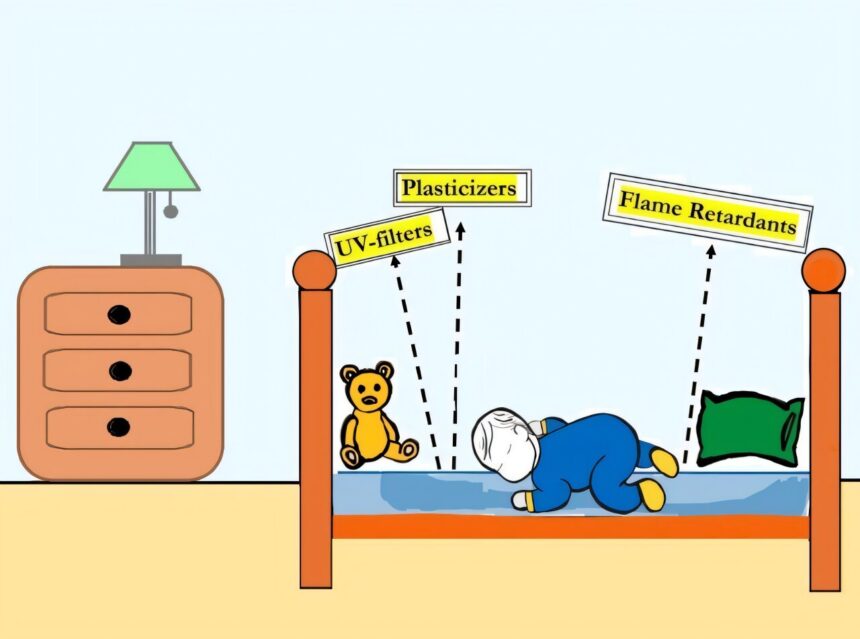Babies and young children may be at risk of inhaling and absorbing harmful chemicals such as plasticizers called phthalates and flame retardants from their mattresses while they sleep, according to recent studies conducted by the University of Toronto. These chemicals have been associated with various health issues, including neurological and reproductive problems, asthma, hormone disruption, and cancer.
“Sleep is crucial for brain development, especially in infants and toddlers. However, our research indicates that many mattresses contain chemicals that could potentially harm children’s brains,” stated Miriam Diamond, a professor at the University of Toronto and senior author of the studies.
The first study conducted by researchers involved analyzing the chemical concentrations in 25 children’s bedrooms, ranging from ages 6 months to 4 years. They found elevated levels of more than two dozen phthalates, flame retardants, and UV filters in the bedroom air, with the highest concentrations observed near the beds.
In a companion study, 16 newly purchased children’s mattresses were tested, confirming that these mattresses are a significant source of the chemicals found in children’s sleeping environments. When subjected to simulated conditions of a child’s body temperature and weight, the emissions of these chemicals increased substantially, sometimes by several times.
Most of the mattresses tested were purchased in Canada but contained materials sourced from other countries like the U.S. and Mexico. Given the interconnected nature of mattress markets and supply chains, the findings are likely applicable to mattresses purchased across North America.
The identified phthalates and organophosphate ester flame retardants are known to disrupt hormones and are associated with neurological impairments, such as learning disorders, reduced IQ scores, behavioral issues, and memory problems. Some of these chemicals are also linked to childhood asthma and cancer. Additionally, several UV filters present in the mattresses are hormone disruptors.
Children are particularly vulnerable to these chemicals due to their ongoing development, hand-to-mouth behaviors, higher breathing rates compared to adults, more permeable skin, and a larger skin surface area relative to their body weight.
The excessive levels of flame retardants in the tested mattresses raised concerns since these chemicals are not required to meet Canadian or U.S. flammability standards for mattresses. Flame retardants have been associated with neurological, reproductive, and hormonal issues, along with cancer, without providing a proven fire safety benefit in mattresses.
“Parents should feel confident that their children are safe and secure when going to bed. Flame retardants have a long history of negatively impacting children’s cognitive function and learning abilities. It is worrying to find these chemicals in children’s mattresses, especially when they are not necessary to meet safety standards,” expressed Arlene Blum, Executive Director of the Green Science Policy Institute.
The researchers recommend that manufacturers conduct thorough testing of the chemicals used in children’s mattresses and advocate for stricter regulations on flame retardants and phthalate plasticizers in these products.
In Canada, the researchers suggest extending restrictions on specific plasticizers from toys and objects to include mattresses and other bedding items, as well as implementing long-awaited restrictions on two flame retardants. They also emphasize the importance of manufacturers testing children’s mattresses for banned or restricted chemicals before releasing them to the market.
Meanwhile, parents can take steps to reduce their children’s exposure to these harmful chemicals. Suggestions include decluttering the child’s sleeping area by minimizing pillows, blankets, and toys, regularly washing and refreshing bedding to act as a protective barrier, and opting for undyed or neutral-colored fabrics, which are less likely to contain harmful additives like UV filters.
More information:
Environmental Science & Technology Letters (2025). DOI: 10.1021/acs.estlett.5c00051
Are Sleeping Children Exposed to Plasticizers, Flame Retardants, and UV-Filters from Their Mattresses?, Environmental Science & Technology (2025). DOI: 10.1021/acs.est.5c03560
Provided by Green Science Policy Institute
Citation:
Children exposed to brain-harming chemicals while sleeping: Scientists urge mattress manufacturers to act (2025, April 15)
retrieved 16 April 2025
from https://medicalxpress.com/news/2025-04-children-exposed-brain-chemicals-scientists.html
This document is subject to copyright. Apart from any fair dealing for the purpose of private study or research, no
part may be reproduced without the written permission. The content is provided for information purposes only.








